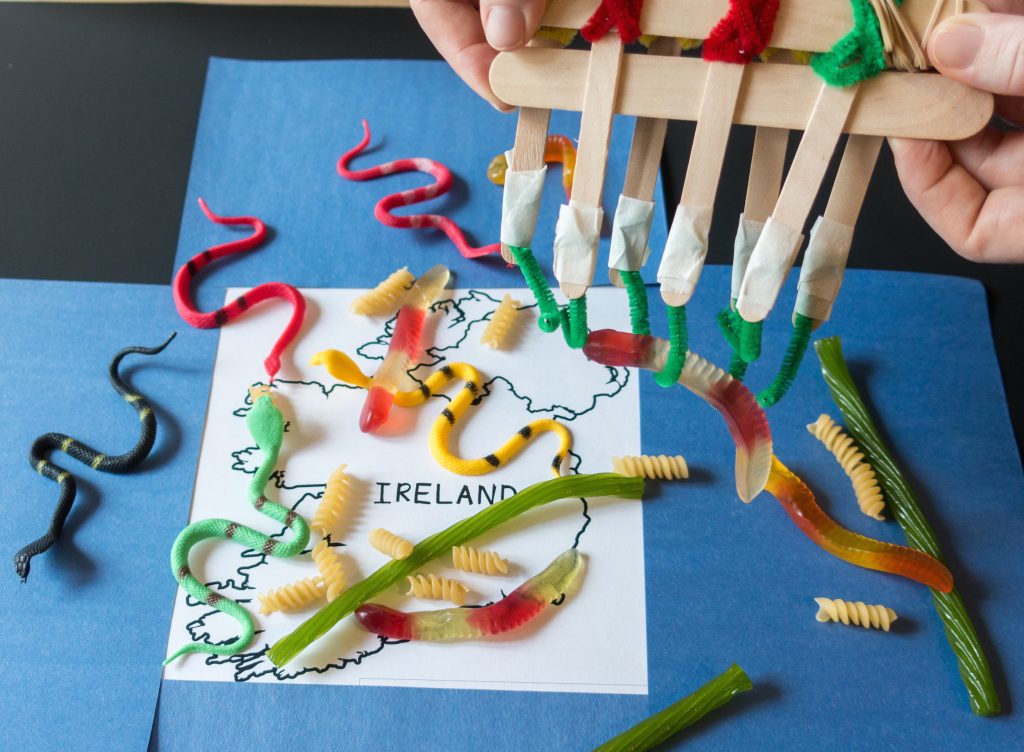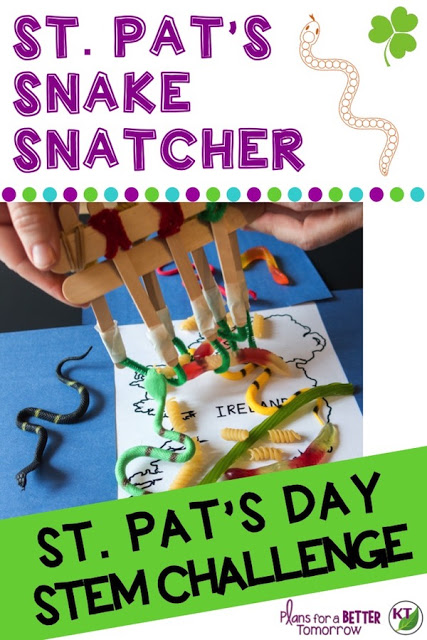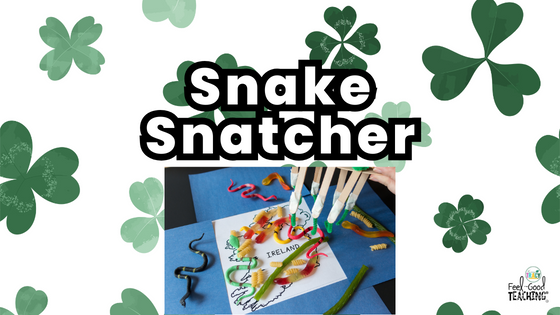We’re using the legend behind the holiday for this St. Patrick’s Day activity STEM Challenge! Legend says St. Patrick drove snakes out of Ireland in the 5th century, though despite popular belief, no evidence suggests snakes were ever there. Celebrated on March 17th, St. Patrick’s Day honors the patron saint and Irish culture globally.
If you are searching for a way to recognize the holiday with your students, why not chose a St. Patrick’s Day activity that is more than just a craft or activity to pass the time. The STEM challenge, Snake Snatcher, is sure to keep your students engaged in brain-busting word disguised as fun!
Premise of St. Patrick’s Day Activity: Snake Snatcher
Individually or in partners/groups, students will design and build a device to rid Ireland of snakes as quickly and safely as possible.
– Snakes (10 – 20) will be spread over a map of Ireland (three map options are provided). Student devices must lift snakes from Ireland and drop them in the surrounding ocean.

Materials for St. Patrick’s Day Activity: Snake Snatcher
The list of materials you’ll need is short and easily modified, making this St. Patrick’s Day activity and STEM challenge simple to incorporate with very little need for additional prep. You’ll need:

Note: The links below are Amazon Affiliate links.
Find out more on the disclosure page.
- Variety of snakes. (10 – 30)
- Gummy worms, Licorice, rotini noodles (raw or cooked), plastic snakes, twisted pipe cleaners, etc.
- Note: there is an option in the challenge to mix in other “creatures” with the snakes to add difficulty. You may elect to designate some of the materials listed above or select new ones.
- Pipe cleaners (5 – 10)
- Craft Sticks (5-10)
- String/yarn (12 – 24 in.)
- Straws (5 – 10)
- Tape (12 – 24 in.)
- Rubber bands (5 – 10)
- Scissors
- Second timer
- Design analysis handouts (included in resource)
- Map of Ireland (Included in resource)
- Place in sheet protectors or laminate (optional)
Optional
- Small cups or bowls
- Blue paper (ocean surrounding Ireland)
- Clothespins or binder clips (3 – 5)
- Paperclips (10 – 20)
- Toothpicks (10 – 20)
Video Walk-through of St. Patrick’s Day Activity: Snake Snatcher
Rather than write it all down for you to read, wouldn’t it be nicer to just sit back and watch? I’ve found creating video walk-throughs of my STEM challenges is the best/fastest way to explain the important details: materials, set-up, tips, modifications, extensions, and more! Check out the video below to learn more about this St. Patrick’s Day activity STEM challenge, Snake Snatcher. However, if you prefer to read, you’ll find the video transcribed at the end of this post.
Are There Other St. Patrick’s Day Activity STEM Challenges Like This?
Of course! I can’t help myself! You’ll find all five of the St. Patrick’s Day activity STEM challenges I’ve created in the 5-challenge bundle briefly described in this post. Each challenge post is linked there for the walk-through videos and more details. You can also find this St. Patrick’s Day activity, Snake Snatcher, alone (top left) or in a bundle of 5 St. Patrick’s Day STEM activities (top right). You may also like the Planetopia Project STEM Challenge Bundle & the Spring & Easter STEM Challenge Bundle. Please reach out with any questions and tag me in photos of your students’ work on Facebook & Instagram!
Video Transcription of St. Patrick’s Day Activity: Snake Snatcher
Hi there, and welcome to challenge number four, St. Pat’s Snake Snatcher. In this one, we are using the legend of St. Patrick driving the snakes out of Ireland. Students will be designing one or more tools in order to clear the snakes out of Ireland as quickly as possible. Let’s take just a second to check out the materials and the STEM Challenge Cycle.
This is the STEM Challenge Cycle you should follow for every challenge. I’ve defined each step in another video. I’ve added a pop-in card to that video here, as well as, a link in the description.
Just a quick reminder with the materials, of course the more you add, the more variety there will be in the student designs. First of all, a material that is not negotiable will be snakes, but you have some options there. You can either get these little toy ones, I have picked mine up from the Dollar Tree.
You can use other pipe cleaners, liquorice, I’ve used Rotini noodles, gummy worms, whatever. You can even use a mixture. We’re gonna make this a little bit easier for your younger students, I would consider adding in binder clips or clothes pins as part of your materials. And of course, when you introduce this challenge to your students you are probably going to need to give them a little bit of background on the history of the holiday.
When the students do this challenge the map is going to be flat on their desk and the snakes scattered around, and they need to design a tool that can safely lift and remove the snakes out of Ireland and dump them into the ocean. And you can determine if you want to blow up the map of Ireland a little bit larger, or even have this entire section be Ireland, and the snakes have to be moved outside of that zone.
A couple of constraints there. The tool needs to allow them to be at least four to six inches away from the snakes at all times, in order to be safe. It actually needs to lift the snake and remove it, as opposed to just wiping it off of the map. If you use something like a liquorice or a gummy worm, I also add a constraint that the snakes cannot be punctured by the tool. And of course the map has to remain fixed, that is, the students can’t lift up the map and shake the snakes off.
One thing you can do to increase difficulty, is to add in some decoys, or mimics, with the snakes. And the mimics have to remain in Ireland while the snakes, the true snakes, are actually removed. Another thing you can do is to actually have teams partner up and sort of work against each other. So team A is using their tool to remove the snakes from Ireland, as team B is using their tool to put the snakes back in Ireland. And that sort of symbolizes that the snakes are still procreating as this process to remove them is taking place. You can also increase the distance that the students have to be away from the snakes.
For measurement, you have two options. You can choose a predetermined time, like 30 seconds, and have the students remove as many snakes as they can in that 30 seconds. In that case of course you want everybody in the group to have a turn to go, then they can average the results or sum them. In the second option you would actually have the students clear all of the snakes out of Ireland, they set the timer and they track how long it takes before all of the snakes are out.
If you did introduce the mimics, let’s say the students cleared out 12 creatures, 10 are snakes and two are mimics, then you can either let them keep a score of 10 for the 10 true snakes, or you can have those two mimics count against two of their snakes and only give them a score of eight. However, you like to do it.
Now, if you introduce mimics, or just another creature that is not meant to be removed, you can either have them look entirely unlike the snakes, or, if you do want them to be closer to mimics, you could use entirely Rotini noodles and mark some with a sharpie, and leave the others without.
To extend on this, you can have the students do some research on snakes, or even expand that out further to reptiles, or even vertebrates. You could study food webs and ecosystems, and talk about the problems that occur when populations are removed or an invasive species is brought in. To introduce mimics and this is a great opportunity to talk about camouflage and mimicry.
And you can even tie in a writing activity. Now, the legend of St. Patrick driving the snakes out of Ireland is just that, it’s a legend, there were never any snakes in Ireland. So you could use that as a jumping off point, and have students write a legend for why there are no lions in the classroom. You could even do a group or a whole class brainstorm on things like that, Lions in the classroom, that were never actually true anyway. That will give students a lot of ideas to choose from for their own writing.
Okay, so now you have all the basics in order to do this in your classroom. But of course there’s more in the resource, so take a look.
This time saving resource contains everything you need, including modifications for use with second through eighth graders. You’ll still need to gather the simple materials of course, but the rest is ready for you. You’ll get Aligned Next Generation Science Standards, links to my STEM challenge How-To videos to help you get the most from each challenge, and the Snake Snatcher materials list.
In Teacher Tips you’ll find premise and setup, how to increase or decrease difficulty through the criteria and constraints list, measuring results, and cross-curricular extension suggestions. You’ll find an editable Criteria & Constraints List, so you can tailor the challenge to your students, and three Ireland map options.
For Student Handouts there are two versions, four-page expanded room for response for younger students, and a two-page condensed space paper saver version. You’ll also find a set of group discussion questions. In the Extension Handouts, you’ll find snake, and mimicry and camouflage research logs, as well as math extension and process flow templates. This resource is available individually, and as part of the discounted St. Patrick’s Day and Mega STEM Challenge bundles. Links can be found in the description bellow the video.
Hope you and your students really enjoy this challenge, it is one of my very favorites. Don’t forget to like and subscribe. I’ll be back next week with the last St. Patrick’s Day activity STEM challenge, the Limitless Luck, it’s also known as Four Leaf Frisbee. Have a great week, I’ll see you next time.
Pin Me!





